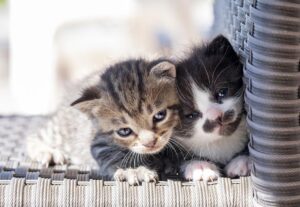Have you ever wondered about the differences between male and female cats?
While both are undeniably adorable, you might wonder which is easier to care for if you're considering getting a cat for the first time.
In this article, we'll introduce the ways to distinguish between male and female cats, their behaviors during heat, their personalities, fur colors, and diseases they're prone to.
Contents
1. How to Distinguish Between Male and Female Cats
∟1-1. By Their Genitals
∟1-2. By Their Faces
∟1-3. By Their Physiques
∟1-4. By Their Behaviors
2. Behaviors During Heat and Spaying/Neutering
∟2-1. Behaviors During Heat
∟2-2. Methods of Surgery
∟2-3. Changes After Surgery
3. Other Differences Based on Gender
∟3-1. Differences in Diseases by Gender
∟3-2. Differences in Fur Colors by Gender
∟3-3. Differences in Personality by Gender
4. Which is Easier to Care For, Male or Female?
Conclusion
1. How to Distinguish Between Male and Female Cats

Let's start by introducing the key points for distinguishing between male and female cats.
1-1. By Their Genitals
The easiest way is to distinguish them by their genitals.
Look above the anus, near the base of the tail.
If it's a male, you'll see two round balls of fur, which are the cat's testicles.
The penis of a cat is about 1 centimeter long and usually covered by skin, making it difficult to see, but the presence or absence of testicles is the easiest way to distinguish between male and female.
Be gentle and careful when trying to distinguish by the genitals, as lifting the tail forcefully or touching roughly can stress the cat.
In the case of kittens, this method is not applicable as their testicles have not developed yet. Male kittens have a greater distance between the anus and the genitals, and the area around the genitals appears more swollen, making it somewhat distinguishable.
If you can't tell the difference, it's best to have a veterinarian make the determination.
1-2. By Their Faces
In adult cats, the shape of the face can give you some indication of their gender.
Males tend to have broader faces, which may appear as if their cheeks are swollen. This is due to the influence of male hormones, making the skin and internal parts of the face thicker, presumably to reduce damage during fights.
Moreover, a larger face may appear more intimidating, which could be advantageous during conflicts.
However, distinguishing solely by the face can be challenging, as chubby female cats may have large faces, and slim male cats may have narrower faces.
1-3. By Their Physiques
Similar to humans, male cats tend to be larger.
There are differences depending on the breed and individual, but for example, in the case of a brother and sister, the physical difference becomes more apparent as they grow.
Males have a more robust skeleton and a sturdier build.
In contrast, female cats tend to have a more delicate build and feel softer when held. This is because, in addition to having a finer bone structure than males, they also tend to have thicker subcutaneous fat to protect their reproductive organs.
1-4. By Their Behaviors
You can also distinguish between males and females by their behavior.
If you see a cat lifting its tail and spraying urine on pillars or walls, it's almost certainly a male. This behavior, known as "spraying," is performed to mark their territory.
However, some female cats also spray, so this is not a 100% certain method.
2. Behaviors During Heat and Spaying/Neutering

Cats reach sexual maturity between the ages of 6 months and 1 year, and begin to exhibit behaviors associated with being in heat.
Male and female cats exhibit completely different behaviors during heat, so it's important to be aware of these changes.
If you do not wish to breed your cat, it's necessary to consider spaying or neutering.
We will also explain the methods for both male and female surgeries and the changes that occur afterwards.
2-1. Behaviors During Heat
Both males and females become restless and more prone to aggression during heat.
They may also cry loudly and show a desire to go outside. It's important to recognize these behaviors during the heat cycle to prevent escape and unwanted pregnancies.
We will introduce the ways males and females behave during heat.
【1】Males
Males do not have a fixed heat period and become aroused in response to the cries or presence of a female in heat. A male cat in heat will exhibit behaviors such as:
- ・Increased spraying activity
- ・Mounting behavior (the action a male performs during mating)
【2】Females
Females go into heat 2-3 times a year, from spring to autumn. During heat, they exhibit behaviors such as:
- ・Raising their hindquarters
- ・Rubbing against objects or writhing
- ・Loss of appetite
2-2. Methods of Surgery
If you do not intend to breed your cat, spaying or neutering can reduce stress for both the cat and the owner.
It also serves as a preventive measure for diseases related to the reproductive organs, which we will discuss later.
The method, duration, and cost of spaying surgery vary between males and females, so it's important to understand these differences.
【1】Male Neutering Surgery
Male cats are typically neutered around 6 months of age.
The procedure involves the removal of the testicles from the scrotum and does not require opening the abdomen, so it's less stressful for the cat, and they can usually go home the same day.
The cost varies by clinic but is generally between 10,000 and 15,000 yen.
【2】Female Spaying Surgery
Female cats are usually spayed between 6 and 8 months of age. Unlike males, females are put under general anesthesia and have their ovaries and uterus removed through an abdominal incision.
The surgery, including anesthesia, takes about an hour to complete, but some clinics may require the cat to stay overnight for observation.
Because it's more extensive than male surgery, it's also more expensive, with costs ranging from 15,000 to 30,000 yen.
2-3. Changes After Surgery
After surgery, both males and females tend to gain weight. This is due to changes in hormone levels and the fact that energy previously needed to maintain reproductive functions is no longer necessary, leading to calorie surplus if the diet remains the same.
In addition, surgery can lead to changes in behavior and personality, such as:
【1】Males
Male cats may exhibit fewer mating behaviors and spray less often after neutering. Their personalities may also become more docile, and they may engage in fewer fights.
However, there is significant individual variation in these changes, and some cats may not show any significant difference in behavior after surgery. This is especially true for cats that have learned to spray, as they may continue this behavior even after being neutered.
【2】Females
Spayed female cats no longer go into heat, eliminating the loud vocalizations associated with this period. Like males, their personalities may also become more gentle.
3. Other Differences Based on Gender

3-1. Differences in Diseases by Gender
An important difference between genders is their susceptibility to certain diseases. It's essential to know which diseases your cat is prone to for prevention and early detection.
【1】Males
Specific diseases in male cats include testicular tumors and prostate diseases, which are related to the reproductive organs and can be prevented by neutering.
Additionally, male cats have a narrower urethra compared to females, making them more susceptible to urinary tract stones and feline lower urinary tract disease (FLUTD).
Diabetes is also more common in male cats, with 60-70% of diabetic cats being males. Like in humans, obesity often leads to diabetes, so it's important to be mindful of your cat's diet.
【2】Females
Females, like males, are susceptible to reproductive organ diseases, especially pyometra and mammary tumors, which can be prevented by spaying.
The female urethra is wider and shorter than the male's, making them less prone to urinary stones but more susceptible to bacterial bladder infections.
Bacterial bladder infections often present with subtle symptoms, requiring a urine test at the vet for diagnosis. Regular urine testing during check-ups can lead to early detection.
3-2. Differences in Fur Colors by Gender
There are differences in the likelihood of certain fur colors appearing in male and female cats.
For example, it's well-known that most calico cats are female.
Similarly, "tortoiseshell" cats with a mix of brown and black fur are almost always female.
However, male calicos and tortoiseshells do exist, though they are extremely rare, with an occurrence rate of about 1 in 3,000 to 4,000. Assuming a calico is female without proper sex determination can lead to issues, such as during spaying procedures.
On the other hand, ginger tabbies (with dense orange stripes) are overwhelmingly male. About 80% of ginger tabbies are male, making female ginger tabbies relatively rare, though not as rare as male calicos.
3-3. Differences in Personality by Gender
It's said that male and female cats differ in personality, though individual differences exist. Generally, the tendencies are as follows:
【1】Males
- ・Active
- ・Affectionate
- ・Curious
- ・Expressive in their emotions
【2】Females
- ・Cool
- ・Independent
- ・Moody
- ・Reserved
4. Which is Easier to Care For, Male or Female?

As mentioned above, female cats tend to be more reserved, while male cats are more affectionate and mischievous.
Moreover, since males are larger and stronger, their mischief can be more intense.
Considering these points, females might be easier to care for, especially for first-time cat owners.
However, the personality differences mentioned are mere tendencies. There are active females and quiet males.
When choosing a cat, it might be better to decide based on the connection you feel with the animal rather than its gender.
Whether easy or difficult to care for, once you start living together, that cat becomes a beloved "family member."



